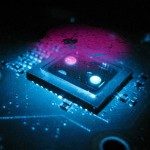Lien vers Pubmed [PMID] – 27341321
J Vis Exp 2016 06;(112)
Mice emit ultrasonic vocalizations in different contexts throughout development and in adulthood. These vocal signals are now currently used as proxies for modeling the genetic bases of vocal communication deficits. Characterizing the vocal behavior of mouse models carrying mutations in genes associated with neuropsychiatric disorders such as autism spectrum disorders will help to understand the mechanisms leading to social communication deficits. We provide here protocols to reliably elicit ultrasonic vocalizations in pups and in adult mice. This standardization will help reduce inter-study variability due to the experimental settings. Pup isolation calls are recorded throughout development from individual pups isolated from dam and littermates. In adulthood, vocalizations are recorded during same-sex interactions (without a sexual component) by exposing socially motivated males or females to an unknown same-sex conspecific. We also provide a protocol to record vocalizations from adult males exposed to an estrus female. In this context, there is a sexual component in the interaction. These protocols are established to elicit a large amount of ultrasonic vocalizations in laboratory mice. However, we point out the important inter-individual variability in the vocal behavior of mice, which should be taken into account by recording a minimal number of individuals (at least 12 in each condition). These recordings of ultrasonic vocalizations are used to evaluate the call rate, the vocal repertoire and the acoustic structure of the calls. Data are combined with the analysis of synchronous video recordings to provide a more complete view on social communication in mice. These protocols are used to characterize the vocal communication deficits in mice lacking ProSAP1/Shank2, a gene associated with autism spectrum disorders. More ultrasonic vocalizations recordings can also be found on the mouseTube database, developed to favor the exchange of such data.


